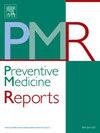美国罗德岛州和康涅狄格州补充营养援助计划参与者的粮食不安全和营养不安全风险
IF 2.4
3区 医学
Q2 PUBLIC, ENVIRONMENTAL & OCCUPATIONAL HEALTH
引用次数: 0
摘要
目的1)描述粮食不安全与营养不安全风险(以下简称营养不安全);2)检验感知食物获取与邻里环境、食物和营养不安全之间的关系,以及这些关系的差异;3)在低收入成年人样本中测试食物和营养不安全与饮食质量之间的关系。方法在2023年5月至9月期间,美国罗德岛州和康涅狄格州补充营养援助计划(SNAP)的参与者(n = 1234)完成了一份食物频率问卷,并计算了健康饮食指数(HEI)-2015得分。一项在线调查包括关于感知到的粮食获取障碍和粮食环境以及粮食和营养安全的问题。我们使用单独调整的回归模型来估计与食物和/或营养不安全相关的因素及其与饮食质量的关系。结果个体年龄为35岁,平均92%为女性,43%为西班牙裔,分别有58%和30%的人食物和营养不安全。HEI-2015平均得分为64分。缺钱与经历粮食不安全的几率高出8倍相关(95%置信区间[CI] = 5.76, 10.67)。与营养不安全的最大关联是附近很少或没有提供全方位服务的杂货店(优势比[or] = 2.27;95% CI = 1.27, 4.06),其次是缺钱和交通不便。食物和营养不安全与HEI-2015之间呈负相关,但无统计学意义。平均而言,SNAP参与者的粮食不安全患病率高于美国人。感知到的粮食获取障碍与粮食和营养不安全有关。本文章由计算机程序翻译,如有差异,请以英文原文为准。
Food insecurity and risk of nutrition insecurity among Supplemental Nutrition Assistance Program participants in Rhode Island and Connecticut, USA
Objective
To 1) describe food insecurity and risk of nutrition insecurity (henceforth nutrition insecurity); 2) test the associations between perceived food access and neighborhood environment and food and nutrition insecurity, and differences in these associations; and 3) test the associations between food and nutrition insecurity and diet quality, among a sample of adults with low income.
Methods
Between May–September 2023, Supplemental Nutrition Assistance Program (SNAP) participants in Rhode Island and Connecticut, USA (n = 1234) completed a food frequency questionnaire, from which we calculated healthy eating index (HEI)-2015 scores. An online survey included questions on perceived food access barriers and the food environment, and food and nutrition security. We used separate adjusted regression models to estimate correlates associated with food and/or nutrition insecurity and their associations with diet quality.
Results
Individuals were 35 years old, on average, 92 % were women, 43 % identified as Hispanic, and 58 % and 30 % were food and nutrition insecure, respectively. The average HEI-2015 score was 64. Lack of money was associated with an 8-fold higher odds of experiencing food insecurity (95 % Confidence Interval [CI] = 5.76, 10.67). The largest magnitude of association with nutrition insecurity was having few or no full-service grocery stores nearby (Odds Ratio[OR] = 2.27; 95 % CI = 1.27, 4.06), followed by lack of money and limited transportation. Associations between food and nutrition insecurity and HEI-2015 were negative but not statistically significant.
Conclusions
The prevalence of food insecurity among SNAP participants was higher than Americans, on average. Perceived food access barriers were associated with food and nutrition insecurity.
求助全文
通过发布文献求助,成功后即可免费获取论文全文。
去求助
来源期刊

Preventive Medicine Reports
Medicine-Public Health, Environmental and Occupational Health
CiteScore
3.90
自引率
0.00%
发文量
353
 求助内容:
求助内容: 应助结果提醒方式:
应助结果提醒方式:


